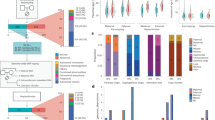Abstract
The sex ratio in the first trimester of pregnancy shifts toward males due to increased elimination of female embryos. One reason for this phenomenon may be disruption of X chromosome inactivation. In this paper, we have analyzed the nature of the X chromosome inactivation in extraembryonic tissues of induced and spontaneous abortuses with 46,XX karyotype. Both equiprobable and asymmetric inactivation have been found in chorionic cytotrophoblast from spontaneous and induced abortuses. In the extraembryonic mesoderm of the control group of embryos, only equiprobable inactivation has been found, whereas this parameter was shifted in 15% of spontaneous abortions. The highest incidence of the selective inactivation of one of the parent homologues was found in the group with a lack of development of embryos and embryos from women with recurrent miscarriages. One of the reasons for the observed results can be compartmentalization of cells in the blastocyst leading to the nonrandom redistribution of cells and the predominance in the inner mass of cells with an active X chromosome with aberrations incompatible with normal embryonic development.
Similar content being viewed by others
Abbreviations
- EM:
-
extraembryonic mesoderm
- MA:
-
medical (induced) abortus
- SA:
-
spontaneous abortus
- CC:
-
chorionic cytotrophoblast
- XCI:
-
X-chromosome inactivation
References
Allen, R.C., Zoghbi, H.Y., Moseley, A.B., Rosenblatt, H.M., and Belmont, J.W., Methylation of HpaII and HhaI sites near the polymorphic CAG repeat in the human androgen-receptor gene correlates with X chromosome inactivation, Am. J. Hum. Genet., 1992, vol. 51, no. 6 pp. 1229–5.
Evdokimova, V.N., Nikitina, T.V., Lebedev, I.N., Sukhanova, N.N., and Nazarenko, S.A., On the question of the sex ratio in the early embryonic lethality in humans, Russ. J. Dev. Biol., 2000, vol. 31, no. 4 pp. 251–5.
Kuo, P.L., Huang, S.C., Chang, L.W., Lin, C.H., Tsai, W.H., and Teng, Y.N., Association of extremely skewed X-chromosome inactivation with taiwanese women presenting with recurrent pregnancy loss, J. Formosan Med. Assoc., 2008, vol. 107, pp. 340–4.
Lau, A.W., Brown, C.J., Penaherrera, M.S., Langlois, S., Kalousek, D.K., and Robinson, W.P., Skewed X-chromosome inactivation is common in fetuses or newborns associated with confined placental mosaicism, Am. J. Hum. Genet., 1997, vol. 61, pp. 1353–4.
Lebedev, I.N., Kashevarova, A.A., Skryabin, N.A., Nikitina, T.V., Lopatkina, M.E., Melnikov, A.A., Sazhenova, E.A., Ivanova, T.V., and Evtushenko, I.D., The matrix comparative genomic hybridization (array-CGH) in the diagnosis of chromosomal imbalance, Zh. Akush. Zhen. Bol., 2013, vol. 62, no. 2 pp. 117–5.
Moreira de Mello, J.C., de Araújo, E.S., Stabellini, R., Fraga, A.M., de Souza, J.E., Sumita, D.R., Camargo, A.A., and Pereira, L.V., Random X inactivation and extensive mosaicism in human placenta revealed by analysis of allelespecific gene expression along the X chromosome, PLoS One, 2010, vol. 5, pp. e10947.
Mutter, G.L. and Boynton, K.A., PCR bias in amplification of androgen receptor alleles, a trinucleotide repeat marker used in clonality studies, Nucl. Acids Res., 1995, vol. 23, pp. 1411–4.
Orstavik, K.H., Skewed X inactivation in healthy individuals and in different disease, Acta Pediatrica Suppl., 2006, vol. 95, pp. 24–4.
Orzack, S.H., Stubblefield, J.W., Akmaev, V.R., Colls, P., Munné, S., Scholl, T., Steinsaltz, D., and Zuckerman, J.E., The human sex ratio from conception to birth, Proc. Natl. Acad. Sci. USA, 2015. pii: 201416546.
Ostroverkhova, N.V., Nazarenko, S.A., Lebedev, I.N., Cheremnykh, A.D., Nikitina, T.V., and Sukhanova, N.N., Detection of aneuploidy in spontaneous abortions by comparative genomic hybridization, Russ. J. Genet., 2002, vol. 38, no. 2 pp. 1690–5.
Peñaherrera, M.S, Jiang, R., Avila, L., Yuen, R.K., Brown, C.J., and Robinson, W.P., Patterns of placental development evaluated by X chromosome inactivation profiling provide a basis to evaluate the origin of epigenetic variation, Hum. Reprod., 2012, vol. 27, pp. 1745–4.
Plenge, R.M., Hendrich, B.D., Schwartz, C., Arena, J.F., Naumova, A., Sapienza, C., Winter, R.M., and Willard, H.F., A promoter mutation in the XIST gene in two unrelated families with skewed X-chromosome inactivation, Nat. Genet., 1997, vol. 17, pp. 353–4.
Sullivan, A.E., Lewis, T., Stephenson, M., Odem, R., Schreiber, J., Ober, C., and Branch, D.W., Pregnancy outcome in recurrent miscarriage patients with skewed X chromosome inactivation, Obstet. Gynecol., 2003, vol. 101, pp. 1236–4.
Tolmacheva, E.N., Kashevarova, A.A., and Lebedev, I.N., The inactivation of the X chromosome and human pathology, Med. Genet., 2009, vol. 8, no. 9 pp. 9–5.
Tolmacheva, E.N, Kashevarova, A.A, Sukhanova, N.N., Kharkov, V.N., and Lebedev, I.N., Asymmetric inactivation of the X chromosome in human embryos with mosaic trisomy of chromosome 16, Russ. J. Genet., 2011, vol. 43, no. 3 pp. 401–5.
Uehara, S., Tamura, M., Nata, M., Ji, G., Yaegashi, N., Okamura, K., and Yajima, A., X-chromosome inactivation in the human trophoblast of early pregnancy, J. Hum. Genet., 2000, vol. 45, pp. 119–4.
Vasques, L.R., Klocker, M.N., and Pereira, L.V., X chromosome inactivation: how human are mice?, Cytogenet. Genome Res., 2002, vol. 99, pp. 30–4.
Zeng, S.M. and Yankowitz, J., X-inactivation patterns in human embryonic and extra-embryonic tissues, Placenta, 2003, vol. 24, pp. 270–4.
Author information
Authors and Affiliations
Corresponding author
Additional information
Original Russian Text © E.N. Tolmacheva, S.A. Vasil’ev, E.A. Sazhenova, D.I. Zhigalina, E.I. Grigorovich, T.V. Nikitina, A.A. Mel’nikov, E.S. Zhabina, T.V. Ivanova, I.D. Evtushenko, I.N. Lebedev, 2015, published in Tsitologiya, 2015, Vol. 57, No. 11, pp. 808–812.
Rights and permissions
About this article
Cite this article
Tolmacheva, E.N., Vasil’ev, S.A., Sazhenova, E.A. et al. Skewed X-chromosome inactivation in human miscarriages. Cell Tiss. Biol. 10, 55–59 (2016). https://doi.org/10.1134/S1990519X16010119
Received:
Published:
Issue Date:
DOI: https://doi.org/10.1134/S1990519X16010119




